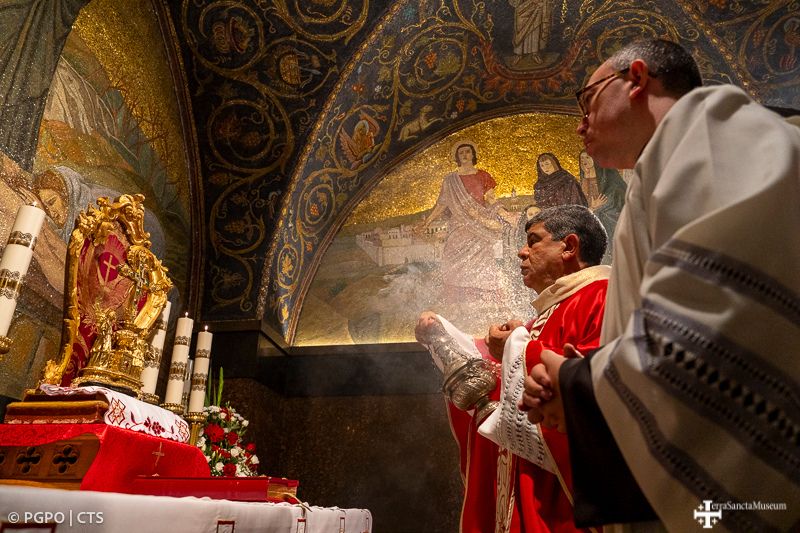The Terra Sancta Museum in Jerusalem, a missionary museum
As 2024 draws to a close, structural work on the future Terra Sancta Museum – Art & History in Jerusalem is nearing completion. The project is now in the hands of the architects and scenographers, who will patiently design each room and showcase of the 890m² of exhibition space, leaving nothing to chance: “It’s a real confrontation with reality. With the scientific committee, we’ve dreamed of a museum, studied our collections, drawn up an itinerary and a discourse, defined initial intentions; now we’re entering a new phase. It’s a question of the project’s practical feasibility,” says a delighted Brother Rodrigo Machado Soares, superior of the Saint-Sauveur convent and the museum’s discreet kingpin.

A Brazilian friar who has been in the Holy Land since 2013, he is committed to this project because, in his eyes, it has a singular missionary dimension. “Franciscans are not art collectors. Our collection is primarily made up of gifts offered, as an act of devotion, to the various shrines in the Holy Land to celebrate divine worship. These works reflect the artistic styles of different cultures, countries and eras. I see this museum as an invitation to contemplate the beautiful. Not beauty for beauty’s sake, but an invitation to go beyond the visible and catch a glimpse of something greater: the Lord manifesting Himself. And Brother Rodrigo likes to quote Saint Augustine in his Confessions: “I loved you very late, O beauty so ancient and so new, very late, I loved you! And behold, you were inside, and I was outside, and that’s where I was looking for you. The Franciscans of the Holy Land have taken up this challenge with the Terra Sancta Museum, using works of art to connect with a transcendental reality. And our Brazilian brother illustrates his point: “Admire the splendor of antependium (altar frontal decoration) donated by the Commissariat of the Holy Land in Naples in 1731. The noblest material was sought, chased and embossed silver, to manifest the Mystery of the Holy Spirit descending upon Mary and the apostles.”

For the time being, it’s easy to see how much cultural mediation and didactic work will be required to accompany the various visitors, believers and non-believers alike, in their discovery of these works. Brother Rodrigo is convinced: “The mission will really begin when the museum opens. It’s not enough to have beautiful works. Other museums have them too, and it’s going to be a question of bearing witness, then as now, to the importance of the Holy Places. Art is a contemporary way of relating to the Holy Places. Everything will depend on the story we tell, the experience we succeed in drawing visitors into”.
In keeping with this “liturgical DNA”, some of the most significant works will have to leave the museum’s display cases to join the altar and sacristy on certain feast days. For example, the famous antependium, measuring 2.40 meters wide, will be moved to the church of Saint-Sauveur for the feast of Pentecost. Its Neapolitan “cousin”, the tabernacle by Andrea de Blasio, will be released on Holy Thursday. As for the staurotheque, made by Rémond Lescot (1628 in Paris), it is used for the feast of the exaltation of the Holy Cross on Calvary. And the golden rose offered by Pope Paul VI in 1964 will continue to be carried in procession to Bethlehem for Epiphany.


“If I tell you about Christ’s funeral, it’s even more obvious. It’s a unique celebration that takes place in the Basilica of the Holy Sepulchre on Good Friday, and preserves a tradition already mentioned in the specific ceremonial of the Custody of the Holy Land in 1754. Some of the works were donated specifically for their use and are true witnesses to the liturgy specific to the Holy Land”. For example, the Bas-Relief of the Resurrection, donated by Cardinal Giacomo Antonelli in 1875 for placement in the tomb aedicule, or the Arma Christi ornaments, donated by the Lombardi commissariat for the Good Friday liturgy on Calvary.
On these occasions, “it’s obvious that we’ll have to find a way of letting visitors know that this or that work is not on loan to another museum, but is being temporarily returned to its original use, because that’s what makes our collection so unique: we’re talking about living collections!” concludes the Franciscan.




